A brief guide on how to order fish in Portugal
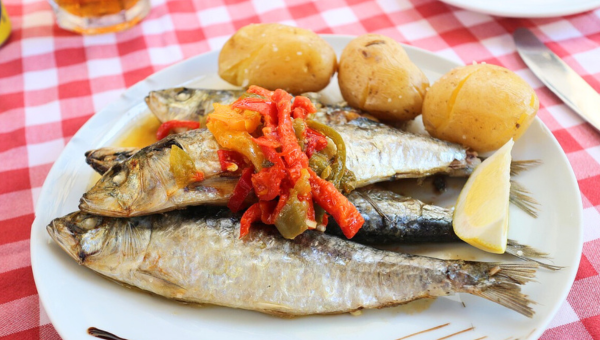
Portugal eats a lot of fish. In fact, we are one of the countries in the world that consumes fish the most and, when you visit Portugal, you’ll quickly notice how fish is such an important part of Portuguese food culture. That is noticeable in markets, in home kitchens, and especially in the way fish is highlighted in restaurant menus.
Fish isn’t a special occasion food here. It’s a part of weekday lunches, including budget friendly dinners, and it’s often what’s on offer at the local tasca when you ask for the dish of the day (prato do dia). This has a lot to do with geography, of course. The Atlantic Ocean shapes the country’s coastline, our economy, and food culture, especially in the north and central regions, where what we eat often follows what’s known as the Atlantic diet. That means vegetables, olive oil, legumes, and lots of fish. In the south, particularly in the Algarve, there’s a more Mediterranean influence, but fish still dominates.
If you’re visiting Portugal and plan to eat out, chances are you’ll come across more than a few fish dishes on restaurant menus. But knowing what to order, how much to order, and how to eat it once it lands in front of you can be a little confusing if you’re not used to it. This guide will walk you through how to order fish at a Portuguese restaurant like a native local. That includes understanding the menu, spotting the difference between wild and farmed fish, reading prices that are listed per kilo and, because fish in Portugal doesn’t always come neatly filleted or disguised in batter, we’ll even talk about how to deal with bones, skin, heads and all.
Feat photo YUNYU via Pixabay
How to read a Portuguese fish menu like a local
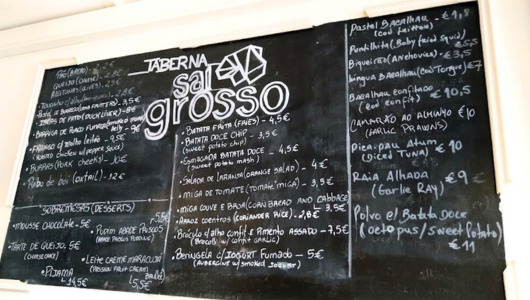 Photo by Wheree
Photo by Wheree
On plenty of Portuguese menus you’ll find fish and salted cod (aka balhacau) listed under separate sections. Even though bacalhau is technically fish, it’s treated differently, both in terms of preparation and cultural weight, and that is why it’s often given its own entire section in menus. For many, bacalhau is not entirely fish, but it’s not meat either, so it’s a category of its own. In this guide, we focus mostly on how to order and eat fresh fish at restaurants. To learn more about Portugal’s obsession with bacalhau you can check out our article about the best Portuguese salt cod dishes and where to eat them in Lisbon.
One thing that often surprises visitors browsing a typical Portuguese menu is that not all fish is priced the same way. Some appear on the menu with a fixed price per portion (dose), while others are sold by weight. This usually reflects whether the fish is farmed, like gilt-head bream (dourada) or European seabass (robalo), which tend to be fairly consistent in size; or wild-caught, which tend to vary much more in size. Wild fish is often priced by the kilo, though smaller species like sardines or tuna steaks are still wild but usually priced per portion. When in doubt, ask whether the price is per kilo and what that translates to in terms of portion size.
You’ll quickly notice that not all available fish are listed on the menu and even when they are, prices might be missing or written on a board somewhere instead. That’s because the fresh fish offering changes constantly depending on the daily catch, and so do the prices. Even for the same species, the cost per kilo can vary from one day to the next based on market supply. Rather than print new menus all the time, many restaurants, especially traditional establishments, keep it flexible. They’ll list a few staples on the menu, but the rest of the fresh fish options are usually shared verbally by the waiter. This is why asking the right questions is important.
If you want to know what’s available, ask:
“Qual é o peixe do dia?” What’s the fish of the day?
To get a sense of price and weight, say:
“Quanto custa ao quilo?” How much is it per kilo?
“Quantos gramas tem, mais ou menos?” Roughly how many grams is it?
If you want to see the fish before ordering (which is perfectly normal):
“Posso ver o peixe antes?” Can I see the fish first?
Often the waiter will say something like “Hoje temos salmonete, sargo e peixe-espada preto, todos grelhados”, that is, “today we have red mullet, white seabream, and black scabbardfish, all grilled.” That’s your cue to ask questions or pick what you like based on what’s fresh. If you’re unsure, just ask what they recommend, saying something like “Qual é o mais fresco?”, which means “which one is the freshest?”
As for preparation, keep an eye out for words like escalado (butterflied open), inteiro (whole), or filetes (fillets, usually boneless and easier for beginners). Many grilled fish dishes will come escalado or inteiro, depending on the species. Furthermore, it’s also useful to know that posta means a thick cross-section cut, often from larger fish like Atlantic wreckfish (cherne) or tuna (atum).
Side dishes are usually standard, including boiled potatoes (batata cozida), smashed roasted potatoes (batata a murro), vegetables, or rice with salad. In some places, loose saucy rice (arroz malandro) might also appear. Check if sides are included, especially in touristy spots, as sometimes they’re charged separately.
Generally speaking, at least in typical restaurants, don’t expect heavy sauces or marinades. Portuguese fish dishes are about letting the fish speak for itself, seasoned simply with olive oil, salt, garlic and maybe a little splash of lemon. If you see a counter with fresh fish on display or fish on ice by the window, that’s a good sign.
The most common fish you’ll find in Portuguese restaurants
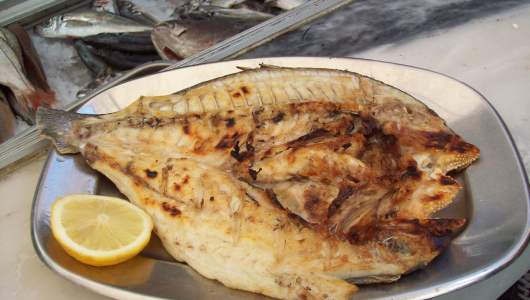 Photo by Viet-hoian1 on Wikimedia Commons
Photo by Viet-hoian1 on Wikimedia Commons
There’s a huge variety of fish in Portuguese waters, but when you’re eating out, there are a few species you’ll run into over and over again. They are amongst the most common because they’re widely available and affordable and, in some cases, also because they’re reliable for restaurant kitchens to serve on a consistent basis.
The most common options include a mix of farmed fish and wild fish. The former, as we mentioned above, are generally smaller, more uniform in size, and priced per portion. The latter vary more in size and are typically priced per kilo and are perhaps more common in seafood restaurants and a little more upscale establishments because they are indeed more expensive.
Let’s start with gilt-head bream (dourada) and European seabass (robalo), two of the most common aquaculture fish in Portugal. You’ll often see them simply grilled and served whole (grelhado, inteiro) or butterflied (escalado), as pictured above, with skin and head on. They’re mild in flavor, with soft, white flesh that flakes easily, and they tend to come in at a predictable 300 to 600 grams, perfect for one person. These are popular with both locals and tourists because they’re easy to eat and usually fairly boneless once you open them up.
Hake (pescada) is also popular, as it is a softer white fish that shows up in a few different ways: as grilled fillets, fried with a light batter, or stewed in dishes like caldeirada. It’s one of the most common fishes cooked at home for the kids and, in general, for people who don’t want to deal with too many bones. At home, it’s often a weeknight staple simply boiled with potatoes, veggies like carrots and broccoli, and maybe a boiled egg on the side too. While in restaurants it more likely shows up as filetes de pescada com arroz de tomate, the comfort food combo of hake fillets with tomato rice that takes many Portuguese straight back to childhood.
Among wild-caught fish, sardines (sardinhas) are iconic. They’re especially popular in the summer, grilled whole over charcoal and served with potatoes, salad, or laid on top of a slice of bread during Lisbon’s popular Santo António festival. They’re rich, oily, and full of bones and yes, it’s perfectly acceptable (expected, in fact) to eat them with your hands.
Horse mackerel (carapau) and Atlantic mackerel (cavala) are other affordable oily fish that are often grilled whole, with their bones intact and the skin blistered from the fire. They’re intensely flavorful and extremely local. A Portuguese local saying goes, “Mais vale um carapau jeitoso que um robalo de viveiro”, meaning that it’s better to have a good looking horse mackerel than a farmed seabass, highlighting quality over price or prestige.
For a firmer texture and meatier bite, meagre (corvina) is popular. It’s a large fish, often served as thick steaks or in stews like massada de peixe. Wreckfish (cherne) and monkfish (tamboril) are other big ones, often sold by the kilo and served in chunks rather than whole, especially in dishes like monkfish rice (arroz de tamboril) or fish cataplana (cataplana de peixe). Monkfish, by the way, is a little ugly, but the tail is firm and delicious, and Portuguese cooks know how to work magic with it. So if you see it fresh at a market or restaurant counter, please do not be negatively intimidated by its looks.
If you’re in the Algarve or Madeira, or simply in the coastal area around Setúbal, black scabbardfish (peixe-espada preto) might be amongst the offerings. It’s long, black, and slightly menacing looking before it’s cooked, but mild and flaky on the plate. It’s usually served grilled or fried. In Madeira, side dishes like grilled banana or passion fruit may be included, which might seem unusual to some, but trust us, the pairing works beautifully.
Finally, there are some smaller, regional favorites like red mullet (salmonete), white seabream (sargo), and sole (linguado), all typically grilled and sold by weight. These are usually whole, served with the skin on, and favored by locals who know how to handle a fish with knife and fork (we have tips for this below).
And here’s a bit of local dining etiquette: if someone at the table orders a pricier fish, say a kilo of cherne or corvina to share, it’s common for the waiter to offer it for the whole table because, in Portuguese food culture, such meals are often seen as something to share. If you are not interested in sharing fish with someone else at your table, you may want to clarify about the actual portion they will be serving and perhaps order something else.
Popular ways to cook fish in Portuguese restaurants
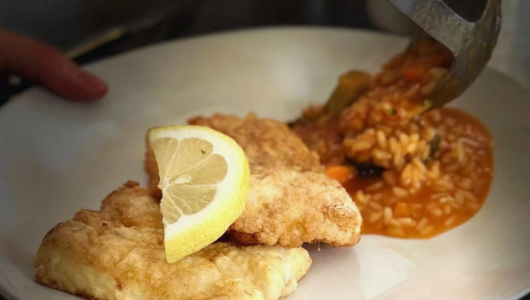 Photo by Cordel Restaurante via Facebook
Photo by Cordel Restaurante via Facebook
In most Portuguese restaurants, fresh fish isn’t drowned in sauce or buried under fancy toppings. The point is to taste the fish and, in general, we trust that the kitchen knows what to do with it. But still, there’s a decent range of cooking styles you’ll come across, and it helps to know what you’re ordering beyond just grilled (grelhado).
Grelhado na brasa, literally charcoal grilled, is by far the most common preparation. It’s the default for whole fish like robalo, dourada, sargo, carapau, or sardinhas. The fish is usually seasoned with just coarse salt and grilled whole, either closed or butterflied open, depending on the species. Don’t expect lemon slices or parsley sprigs as, at most, you’ll get a drizzle of olive oil once it’s off the grill. If the fish comes a little charred on the skin, that’s usually intentional, to enhance the flavor.
No forno means oven-baked. This is more common for larger cuts or chunkier fish like cherne, corvina, or raia, often baked with potatoes, onion, garlic, olive oil, and sometimes tomato or peppers. These are heartier, almost stew-like dishes that feel more homestyle and are usually served in the tray they were baked in.
Frito means fried, and it usually means the fish has been lightly battered or floured and fried. Fish like hake, ray (raia), or filetes de peixe are common in this category, and they’re often paired with tomato rice (arroz de tomate) or kidney beans rice (arroz de feijão), which you should absolutely say yes to.
Cozido means boiled, but this isn’t super common on restaurant menus unless it’s part of a set lunch menu or a lighter option. You may come across it in traditional places.
Then there are the stew-like preparations, which are often served in clay pots or big trays meant for sharing. These are fantastic ways to taste more than one type of fish in a single dish:
– Caldeirada de peixe is a layered fish stew with potatoes, tomatoes, peppers, onion, garlic, and olive oil. Every region, and sometimes every cook, has their own version.
– Massada de peixe is a comforting stew made with a tomato base, and short pasta mixed with fish, sometimes with prawns or shellfish thrown in. Please do not mistake this with Italian fare, as it’s quite different and it feels very Portuguese in terms of flavor profile.
– Arroz de peixe is soupy fish rice, also tomato based, and can range from simple to quite luxurious depending on the fish used and how much of it ends up being thrown into the pot.
– Cataplana de peixe is more common in the Algarve, and it’s named after the clam-shaped copper pan it’s cooked in. It’s usually a mix of fish and shellfish steamed together with herbs, white wine, and vegetables.
Occasionally, you’ll also see dishes prepared à lagareiro, a method typically associated with octopus or salt cod, nevertheless sometimes used for fresh fish too. It involves roasting or baking the fish and then drowning it in garlicky olive oil and is commonly served with smashed potatoes (batata a murro).
You might also come across raia de pitau, that is stingray in a vinegar-garlic sauce, a specialty in Setúbal and nearby regions; or dishes served in a vinegary marinade (com molho de escabeche), usually served cold or at room temperature.
How to order fish by the kilo in Portugal (and not end up overpaying)
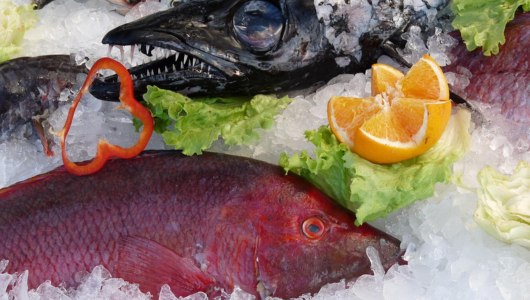 Photo by falco via Pixabay
Photo by falco via Pixabay
Like we have explored above, if you’re ordering wild fish in Portugal, there’s a good chance it’s priced by the kilo. This doesn’t mean you’re expected to eat a kilo of fish on your own. It means the total cost will depend on the weight of the raw fish before it’s prepared, and that can vary a lot depending on the species and size.
Here’s the part that catches a lot of visitors off guard: restaurants don’t always list the final portion price because they don’t know it until they weigh the fish. So if you see something like “cherne 58€/kg”, that’s the price per kilo of the whole, raw fish. Once it’s cleaned and grilled, you’ll be served the agreed-upon amount, ideally after confirming the size and estimated price with the waiter. If you’re sharing a whole fish between two people, most restaurants will suggest something in the 700g to 1.2kg range, depending on the species. For a single person, a 350g to 500g fish is usually the sweet spot. Keep in mind that this is the raw weight, and after cleaning and cooking, you’ll lose around 20 to 30%, depending on the fish. So a 400g robalo might give you about 300g of actual food on the plate, bones included. And this applies mostly to larger, wild-caught species sold whole. Fish like sardines or tuna steaks don’t follow this model, as they’re usually portioned and priced individually, even though they’re wild.
Always confirm the weight and estimated total price before they cook it. This is a normal, accepted practice, and you shouldn’t feel awkward asking. You can say:
“Quantos gramas tem?” How many grams is it?
“Quanto fica mais ou menos?” How much will it be, roughly?
Most restaurants will bring the fish out to show you before it hits the grill, both as a courtesy and as a little moment of theatre. If they don’t offer, you can certainly ask. And if you’re in a place that feels touristy and the prices aren’t clear, be extra cautious. Some spots inflate the final bill by not explaining how much you’re actually paying (for the fish itself or the side dishes) until it’s too late. That’s not the norm, but we have to be realistic and face that it certainly does happen.
It’s worth stressing that you’re always paying for the full weight of the fish, not the net weight of what lands on your plate. A whole grilled fish has bones, head, and skin, and some of that is going in the bin. That’s all factored into the price, so don’t be surprised if a 900g fish turns into a considerably smaller serving. This is also why grilled fish tends to be served with simple, low-cost sides, like the ones we mentioned earlier, to balance out the dish both nutritionally and financially.
As for portion sizes, you don’t have to overthink it:
– Small whole fish (like farmed robalo or dourada) are usually one per person.
– Larger fish (like cherne, corvina, atum, or tamboril) are often served as steaks (postas) or in chunks, and one fish might feed two or more people.
– Fillets and smaller cuts are more common in set menus, stews, or fried dishes and are usually priced per portion.
Whether you’re splurging on a fancier wild fish or simply going for a humble but delicious plate of grilled sardines, we recommend that you always clarify with the staff before they start preparing your order.
How to pick a good fish from the counter or window display
 Photo by Iren via Pixabay
Photo by Iren via Pixabay
Some Portuguese establishments, especially traditional seafood restaurants (marisqueiras) have a glass display with fish laid out on ice (sometimes it’s simply on a refrigerated counter), either near the kitchen, by the entrance, or even in the window. This is the restaurant’s way of showcasing what they have, and it’s also a sign that it is fresh. These displays aren’t appealing for some, but we have to agree that they are usually a good sign, as you can see clearly what you’re about to eat.
Picking a good fish doesn’t require a marine biology degree. It’s mostly about trusting your eyes and nose. Here’s what to look for:
– The eyes should be clear and full, not cloudy or sunken.
– The gills should be bright red or pink, not brown or greyish.
– The skin should be shiny, with a healthy looking layer of natural mucus, meaning a little slime is a good thing.
– The flesh should look firm and bounce back when pressed. You’re usually not allowed to touch, but you request that the waiter do this for you.
– The smell is also crucial. A fresh fish smells like the ocean, but not funky like during low tide.
If you’re choosing a fish for the grill, ask whether it’s farmed or wild, and whether it’s been frozen. Frozen isn’t always bad, but it’s good to know. You can ask:
“É selvagem ou de viveiro?” Is it wild or farmed?
“Foi congelado?” Was it frozen?
Interacting with the waiter before you order fish is part of the experience, so don’t be shy about it and clear up any doubts you may have before they go ahead with your order.
How to eat a whole fish like a Portuguese local
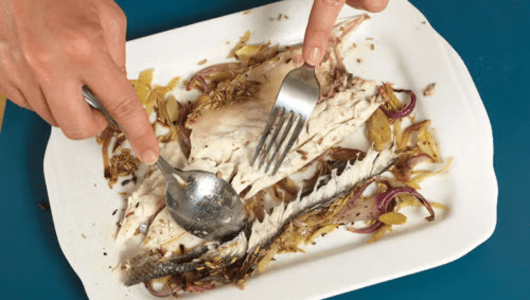 Photo by Clean Eating Magazine
Photo by Clean Eating Magazine
If you’ve ordered fish in Portugal and it lands on the table looking like it could still swim, congratulations: you’ve done it right! Whole fish, grilled over charcoal with the head, tail, and bones intact, is the most traditional and, arguably, also the most delicious way to enjoy fresh fish here. But if you’re used to boneless fillets, as many foreign visitors to our country are, the idea of picking through a plate full of skin and spines might feel a little intimidating. Don’t worry, as it’s easier than it looks, and it’s absolutely normal to take your time.
Step-by-step – How to eat a whole fish with a fork and knife:
- Start at the top, not the head. Place your fork just behind the gills and your knife along the spine. Use the knife to make a clean cut along the top of the fish, from head to tail, just above the spine. This opens up the top fillet.
- Peel back the top fillet. Slide your knife under the flesh and gently lift the top fillet off the bones. Use your fork to help hold the fish steady. Place the fillet on the side of your plate.
- Tidy up any stray bones. Look out for tiny pin bones around the edges and near the belly. If you’re unsure, press lightly with your fork, as bones don’t usually hide well when you poke around.
- Expose the spine. Once the top fillet is removed, you’ll see the backbone. Insert your knife under the tail end and lift the whole spine in one piece, head to tail. It should come off cleanly.
- Eat the bottom fillet. Now that the bones are gone, you’re left with the second fillet. It may be slightly moister from resting against the plate, and just as tasty.
- Skin: eat it or not? That’s up to you. For crisp skinned fish like sardinhas or carapau, locals often eat it, as it’s packed with flavor. For softer skinned fish, like pescada, you might want to peel it off. Either way, no one’s judging.
- Heads and cheeks, aka, optional bonus round. Some locals go for the cheeks and head meat, especially in fattier fish like sardines. The cheeks are tender and prized, like the oyster of the fish. If you’re up for it, keep exploring.
If your fish came as a posta, that is, a thick steak-like slice from a large fish like cherne, atum, or corvina, there’s a central spine and cartilage running through the middle. Start by slicing around the outer edge, then carefully work your way toward the center, lifting the meat off the bone. The flavor’s worth the work, we promise.
Of course, if you ordered filetes or loins (lombos), you’re in the easy lane with no bones, just clean pieces of fish. This is a good option if you’re tired, distracted, hungover, or just not in the mood to work before you actually get to eat.
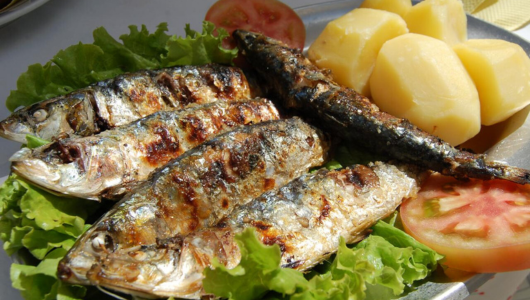 Photo by Yusuke Kawasaki on Wikipedia
Photo by Yusuke Kawasaki on Wikipedia
Grilled sardines, specifically, are best eaten with your hands. They are served whole, with charred skin from the charcoal, and often perched on a slice of bread. So you can gently pull off the head, then split the fish open with your fingers and lift the spine out in one piece. If it falls apart, it’s no problem, as this is rustic food, not fine dining. Use the bread to soak up the juices, and eat it last as part of this delicious ritual. That’s when a true Portuguese sardine lover asks to toast that slice of bread soaked in sardine fat on the charcoal grill. It’s what we Portuguese native locals call a real treat!
Take your time while learning how to eat whole fish, especially with a fork and knife. It can be a fun process and, as a bonus, you’re likely to earn a certain level of respect from the locals when they see you’ve got the hang of it.
How to eat fish in Portugal in a more sustainable way
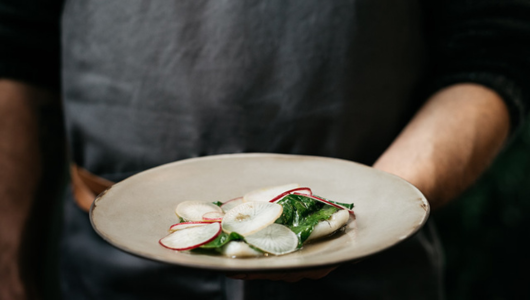 Photo by Prado
Photo by Prado
Most Portuguese restaurants don’t make a big show of sustainable seafood, but that doesn’t mean it isn’t part of the equation. Many places, especially traditional ones, naturally follow seasonal rhythms, simply because that’s how the supply chain works. What’s fresh and affordable is usually what’s on the menu. If you truly care about sustainable fish though, while in Lisbon, we recommend going out to restaurants like Prado (Tv. das Pedras Negras 2), Rosamar (Rua da Rosa 317), or SEM (Rua das Escolas Gerais 120).
Sardines, for example, are at their peak in the summer months, especially between June and August, when the fat content is highest and the flavor is unbeatable. That’s why you see them grilled everywhere during Lisbon’s popular festivals. Outside of that window, sardines might still appear, but often frozen, so it’s worth asking. Canned sardines are also an option and, not only are they super tasty, they are very versatile too.
Mid to late week is generally a better time to order fish than on Mondays. Most fish markets are closed on Sundays, so unless the restaurant receives direct supply or stocks well, Monday’s catch might be from Saturday. Tuesday to Friday is when you’re most likely to get the best and freshest product.
If sustainability matters to you, and we believe it should, here are a few small things you can do:
– Ask if the fish is wild or farmed. Wild doesn’t automatically mean better, but it can help guide your choices.
– Be open to underrated species. Fish like carapau, cavala, and raia are delicious, more sustainable, and often overlooked in favor of trendier or pricier options.
– Avoid overfished species when possible. Certain fish species, such as peixe-espada or cherne, may be flagged in specific regions due to declining stocks, and regulations are being implemented to address this issue. Other species, like eels and lamprey caught in rivers, are unfortunately amongst Portuguese foods that are disappearing.
Portugal is a small country with a big appetite for seafood, and like everywhere, balancing tradition with environmental impact is an ongoing debate. Choosing what’s in season, what’s local, and what’s responsibly caught helps keep the good stuff coming, for everyone.
Ready to eat like a local? Join one of our food and cultural walks in Lisbon to further learn how to make the most of the local food scene, and follow Taste of Lisboa on Instagram, where we show you where the real Lisboetas eat.
Feed your curiosity on Portuguese food culture:
Portuguese food projects you should know and follow
The unofficial rules of pastelaria etiquette: how to order like a local
Best seafood restaurants in and around Lisbon
The ultimate guide to olive oil in Portugal
Peniche travel guide for food lovers
Real people, real food. Come with us to where the locals go.
Signup for our natively curated food & cultural experiences.
Follow us for more at Instagram, Twitter e Youtube
